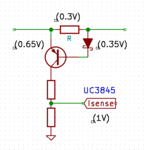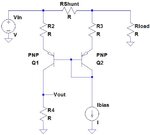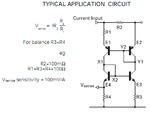kathmandu
Full Member level 5
Hello,
I want to use UC3845 as a control circuit for a DC-DC converter but I want to make some changes regarding the current sense circuit. My requirements are as follow:
(1) high side current sensing (using a shunt resistor)
(2) low voltage drop across that shunt resistor (low power dissipation)
(3) a cheap (no opamps and such) solution
I've designed a circuit like this:

Is there any way to further reduce the voltage drop across the shunt resistor? A voltage drop of 0.1V would be nice.
Do I have to play with BJTs (maybe Darlingtons) and various diode types to aquire that small (0.1V) difference? Is there any other simple solution for this?
I want to use UC3845 as a control circuit for a DC-DC converter but I want to make some changes regarding the current sense circuit. My requirements are as follow:
(1) high side current sensing (using a shunt resistor)
(2) low voltage drop across that shunt resistor (low power dissipation)
(3) a cheap (no opamps and such) solution
I've designed a circuit like this:

Is there any way to further reduce the voltage drop across the shunt resistor? A voltage drop of 0.1V would be nice.
Do I have to play with BJTs (maybe Darlingtons) and various diode types to aquire that small (0.1V) difference? Is there any other simple solution for this?

